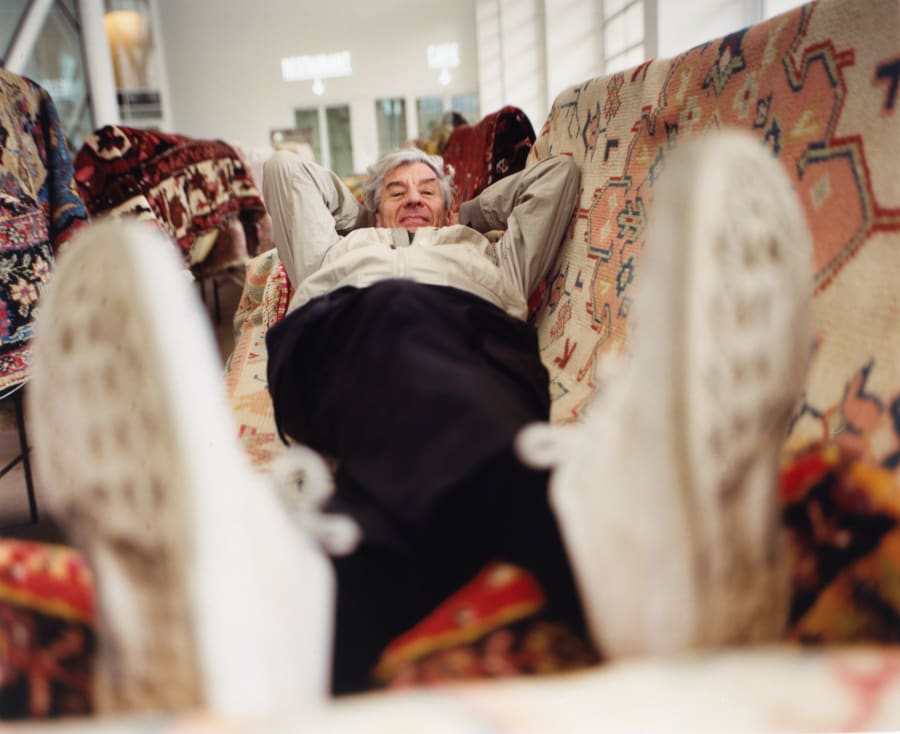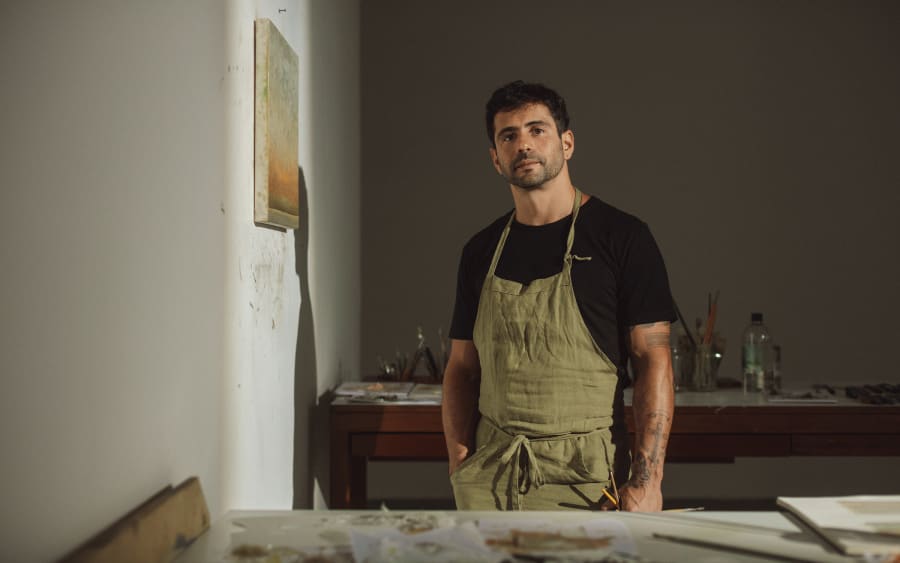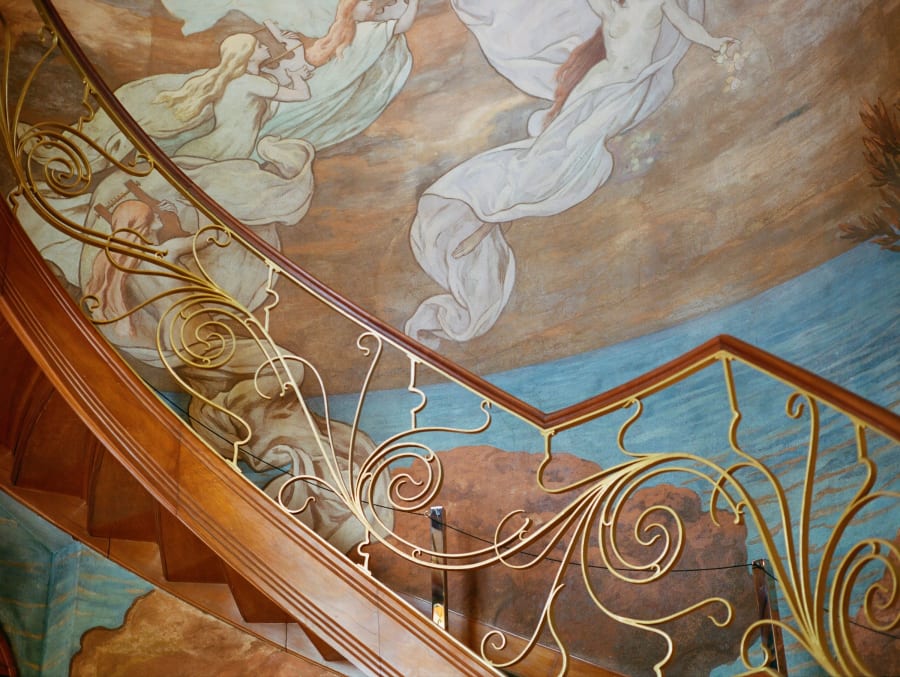從16世紀神秘畫作《加布里埃爾姐妹》(Gabrielle d'Estrées and One of Her Sisters)到皮耶和吉爾(Pierre & Gilles)融合波普與巴洛克風格的戲劇性作品,肖像藝術在西方藝術史長期佔據重要地位,尤其是在法國。 儘管受到形式規範的約束,例如精確的構圖、對主體的忠實再現以及每個姿態中蘊含的豐富象徵,這一藝術形式依然為當代藝術家提供了鮮活而新穎的表達機會。雷恩雅各賓修道院(Couvent des Jacobins Rennes)新展「四目相對」(Les yeux dans les yeux)展出90餘件肖像主題作品;巴塞爾藝術展聚焦六位年輕的法語區藝術家:他們獨特的創作手法為這一經久不衰的藝術形式注入了全新理解。
Rayane Mcirdi(1993年生於巴黎)
如何為這片稱之家園卻為異鄉的土地命名?正是在這種介於歸屬幻想與現實漂泊的中間地帶,Rayane Mcirdi的作品生根發芽。
通過融合個人檔案、口述敘事與詩意場景的影像,Mcirdi探索阿爾及利亞移民的記憶、家族傳承,以及在與他人互動中不斷演進、永恆流動的身份認同。他遊走於民族志紀錄片、自傳體小說和對身邊人物的溫情致敬之間,為那些常常被忽視的故事重新賦予聲音與形體,勾勒出關於家庭與社會關係的親密多元肖像。
通過疊加神話與日常的不同時間維度,Mcirdi譜寫著一段不斷自我重塑的鮮活記憶。無論是《Le Jardin》(2021)中對母輩的追憶,《Le Bord de I'Oise》(2022)對民間傳說的重新詮釋,還是《La Légende d'Y.Z》(2016-2017)中的詩意虛構,都在審視人類與敘事、語言及血脈的關係。
Alireza Shojaian(1988年生於德黑蘭)
因作品涉及伊朗政權禁止的同性戀與酷兒議題,Alireza Shojaian被迫流亡,2019年輾轉黎巴嫩後終獲法國政治庇護。他筆下裸露或半掩的身體,既脆弱又充滿詩意,成為表達抗爭與自由的場域。
在巴黎Bendana-Pinel藝廊的最新個展中,他召喚了兩個強大意象:波斯文學史詩《列王紀》(Shahnameh,977–1010)中的白魔,以及古代神話中反覆出現的燃燒之樹。伊朗文學傳統僅歌頌異性戀英雄,但Shojaian打破了這種單一敘事,使被壓抑的聲音得以顯現。波斯細密畫傳達出集體記憶的聲音,一種縱使流亡在外也拒絕消弭的文化迴響。2022年,其「PaykanArtCar」項目獲得瓦茨拉夫.哈維爾創意異議人士獎(Václav Havel Creative Dissent Award),他將伊朗前國王贈予尼古拉.壽西斯古(Nicolae Ceaușescu)的汽車改造為揭示伊朗社會問題的藝術裝置。
Inès di Folco Jemni(1993年生於巴黎)
法籍突尼西亞藝術家Inès di Folco Jemni的創作靈感源於夢境、前世與神話。她以繪畫為媒介,開啟精神與幻想的旅程。借助儀式與慶典,鼓勵我們重新思考流亡與女性氣質。她的畫布深受其旅行與記憶的滋養。
她獨創的視覺語匯挑戰西方美學,傳遞反殖民壓迫的呼聲,並講述被遺忘的故事,特別是關於奴隸制度和奴隸反抗的歷史。她的作品突破傳統媒介的束縛,巨幅懸垂畫布宛如通往內心世界的門戶。她亦運用閃粉與天然顏料等非常規材料,構建有機實驗室,賦予每種元素新的生命。
奧馬爾.維克多.迪奧普(Omar Victor Diop,1980年生於達卡)
塞內加爾攝影師奧馬爾.維克多.迪奧普是當代非洲藝術界的重要人物。2011年,他辭去英美煙草公司非洲區(British American Tobacco Africa)的工作,投身攝影。他最初在非洲攝影雙年展「遇見巴馬科」(Rencontres De Bamako)嶄露頭角。
他的作品融合了造型藝術、時尚與肖像攝影,結合造型與文本敘事,在多個系列作品中探索多元主題:《Le Futur du Beau》(2011)用廢棄物裝飾模特,質疑審美標準;《The Studio of Vanities》(2012-2015)讚頌非洲創意一代;《Diaspora》(2014)追溯非洲歷史上的肖像作品;《Liberty》(2016-2017)致敬黑人為爭取自由的鬥爭;《Allégoria》(2021)則關注非洲大陸面臨的環境挑戰。
迪奧普的作品講述一個完整的故事,既深植歷史傳統,又與當下緊密關聯,在歌頌血脈根基的同時,也見證了族群的韌性與持續發展。
Nanténé Traoré(1993年生於巴黎)
Nanténé Traoré畢業於南特高等美術學院(École des Beaux-Arts de Nantes),其藝術實踐融合攝影與寫作,遊走於私密紀錄片與虛構敘事之間。他的作品常以流動不羈的運動之軀為載體,探索存在與虛無、留存與消逝之間的張力。他重複手勢、文字與圖像,以敘事抵抗遺忘,守護親密、珍貴和脆弱的事物。
無論是攝影還是文字,Traoré都試圖以詩意的視角捕捉真摯的情感。受攝影師彼得.胡加爾(Peter Hujar)啟發,他構建了一套感性的圖像誌,敘說溫柔、傳承與自由,並以尊重且真誠的視角記錄酷兒群體的日常生活。
Maty Biayenda(1998年生於納米比亞)
Maty Biayenda自幼癡迷繪畫,先後求學於École d'Art du GrandAngoulême,以及巴黎Ateliers de Sèvres,後獲巴黎國立高等裝飾藝術學院(École des Arts Décoratifs)的紡織與材料設計學位。這位法籍剛果藝術家的作品探索非洲移民在歐洲社會中的複雜身份認同和被邊緣化的記憶。她運用豐富的創作媒介,涵蓋繪畫、織毯、攝影、插畫與紡織藝術。Biayenda從家族檔案、歷史文獻以及被遺忘的符號中汲取靈感,構建了受其剛果血脈與跨性別者經歷為啟發的個人敘事。
針對邊緣群體常被以窺探視角與戲劇化方式呈現的現象,她提出質疑,並試圖恢復其真實原貌並解構刻板印象。她的作品向Mary Jones和加勒比變裝藝術家等酷兒與有色人種先驅致敬,並重新詮釋朱伊紋(Toile de Jouy)和中世紀《貴婦與獨角獸》(La Dame à la licorne)織毯等歷史元素。在虛實交織中,她的作品成為角色與藝術家個人經歷對話的場域,個人神話由此徐徐展開。
Rayane Mcirdi由Galerie Anne Barrault(巴黎)代理
Alireza Shojaian由Bendana-Pinel Art Contemporain(巴黎)代理
Inès di Folco Jemni由克雷弗科爾畫廊(Crèvecœur,巴黎)代理
奧馬爾.維克多.迪奧普(Omar Victor Diop)由Magnin-A藝廊(巴黎)代理
Nanténé Traoré由Sultana藝廊(巴黎)代理
Maty Biayenda由Double V藝廊(馬賽,巴黎)代理
頁頂圖片標題:奧馬爾.維克多.迪奧普,《Allegoria 6》(局部),2011,圖片由藝術家及Magnin-A藝廊提供
Yasmin Sarnefors是一位常駐巴黎的作家,也是巴塞爾藝術展內容與傳播助理。
2025年6月24日發佈。


